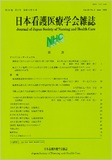Japanese
English
- 有料閲覧
- Abstract 文献概要
- 参考文献 Reference
要旨
【目的】起き上がり動作時の血圧変動を、低血圧(起立性・食事性)の観点から明らかにし、看護への示 唆を得ることである。
【方法】20名の健康な成人を被験者(年齢39.40±10.33歳)とし、食前、食後60分、食後120分の3時点で仰臥位から起立することを指示した。この間、血圧と血糖値を連続的に測定した。
【結果】血圧は、3時点のいずれの場合においても、仰臥位から端座位になる時に有意に上昇した。立位以降に安静時水準に戻った。起立性低血圧は認められなかった(Steel検定)。同様に、起立していない時、すなわち食事だけの影響がある時をみると、食事性低血圧も認められなかった(Bonferroni検定)。また起立動作と食事摂取の影響が重なった場合においても、低血圧は認められなかった。血圧と血糖の間に、相関関係は認められなかった(Pearson検定)。
【考察/結論】健常者においては、仰臥位から端坐位になる時に血圧が上昇することが明らかになった。このことから、看護援助では起き上がり動作の開始時に、細心の注意を払う必要がある。また低血圧については、看護上のリスクが少ないことが示唆された。
[Purpose] The aim of this paper was to analyze blood pressure fluctuations during rising motion from the viewpoint of orthostatic hypotension and postprandial hypotension, and to formulate suggestions for nursing activities such as assistance in rising/standing.
[Method] A total of 20 healthy adults (aged 39.40±10.33 years) were recruited for the trial and instructed to stand from the supine position at three time points: before a meal and at 60 minutes and 120 minutes after a meal. Blood pressure and blood glucose values were continuously measured during these periods.
[Results] At the three time points, blood pressure was significantly higher with drastic fluctuations as the subjects' motions changed from the supine to sitting positions and then returned quietly to the baseline level after standing. No orthostatic hypotension was found (Steel test). Similarly, no postprandial hypotension was found (Bonferroni test). Also, even if the effects of rising/standing and dietary intake overlap, orthostatic hypotension and postprandial hypotension do not occur. There was no correlation between blood pressure and blood glucose (Pearson test).
[Discussion/Conclusion] It was clarified that blood pressure rose during postural changes from the supine to the sitting positions in healthy adults. This finding suggests that nursing assistance should pay close attention at the start of rising/standing motions. Thus, we propose that the risks of hypotension in nursing care are minimal.
Copyright © 2022, Japan Society of Nursing and Health Care All rights reserved.


